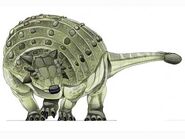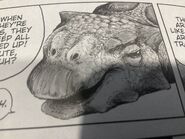| Pinacosaurus Temporal range: Late Creatceous | |
|---|---|
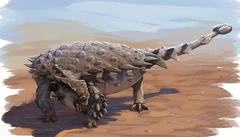
| |
| A restoration of Pinacosaurus | |
| Scientific classification | |
| Kingdom: | Animalia |
| Phylum: | Chordata |
| Class: | Sauropsida |
| Clade: | Dinosauria |
| Order: | Ornithischia |
| Suborder: | Ankylosauria |
| Family: | Ankylosauridae |
| Genus: | †Pinacosaurus Gilmore, 1933 |
| Species: | P. grangeri |
| Binomial name | |
| Pinosaurus grangeri Gilmore, 1933 | |
Pinacosaurus ("plank lizard") is a genus of medium-sized ankylosaur dinosaurs that lived from the late Santonian to the late Campanian stages of the late Cretaceous Period (roughly 80-75 million years ago), in Mongolia and China, most notably inhabiting the Flaming Cliffs formation.
The type species, P. grangeri, was named in 1933. A second possibly valid species was named in 1999, named P. mephistocephalus, based on differences in skull armor compared to P. grangeri. Of P. grangeri many skeletons have been found, more than of any other ankylosaur. The skeletons mostly consist of juveniles that may have lived in herds roaming the deserts of their ecosystem.
One of the best preserved Ankylosaurs, and even dinosaurs as a whole, Pinacosaurus has over 21 preserved skeletons, most of which being juveniles. Including those found in standing positions, laying positions with their belly to the ground, and even a specimen presumed to either be Pinacosaurus or one of its close relatives, found inside a shallow ditch, suggesting it might have even dug. The incredible preservation of Pinacosaurus allows it to be a basis for most of it's close relatives anatomy.
Pinacosaurus was about five meters long and weighed up to two tonnes. Its body was, as the title 'plank lizard' may suggest, flat similar to a plank. It has short, stubby legs making it's body low-slung, though not as heavily built as the larger members of Ankylosaurinae. The heads main defense included of a tile-like bone plate, hence its name. Each nostril was formed as a large depression pierced by between three and five smaller holes, the purpose of which is uncertain. A small and smooth beak and it's prehensile tongue likely assisted in consuming low to the ground foliage. After slicing it up with several teeth, plant matter would be consumed by a massive hind gut. Nearly it's entirely body was protected by an armor of keeled osteoderms. While the tail club was small compared to Ankylosaurus and other members of Ankylosauridae, it would still have been efficient for defending itself. Unlike most Ankylosaurs, Pinacosaurus has a fused mass on it's skull rather than segmented plates.
Discovery and naming[]
The American Museum of Natural History sponsored several Central Asiatic Expeditions to the Gobi Desert in Mongolia in the 1920s. Among the many paleontological finds from the "Flaming Cliffs" of the Djadokhta Formation in Shabarakh Usu were the original specimens of Pinacosaurus, found by Walter Wallis Granger in 1923. In 1933, Charles Whitney Gilmore described a right ilium and a tail vertebra, without yet naming the animal. In a later publication of the same year, he named and described the type species Pinacosaurus grangeri. The generic name is derived from Greek πίναξ, pinax, "plank", in reference to the small rectangular scutes covering the head. The specific name honours Granger, who accompanied the 1923 expedition as a paleontologist.
The holotype, AMNH 6523, was found in a layer of Campanian rock. It consists of a partially crushed skull, lower jaws, the first two neck vertebrae, and dermal bones collected in 1923.[1]

The original skull holotype of Pinacosaurus
At another site, Alag Teeg, many bonebeds have been uncovered, providing up to 100 individuals between 1969 and 2006; most of the specimens haven't been dug up. Whereas ankylosaur skeletons have often been preserved laying on their back, most Pinacosaurus juveniles are found on their belly in a resting position, with the legs tucked in. Because of the many finds, in principle the entire juvenile skeleton is known. Pinacosaurus especially provides information on the build of the ankylosaurian skull, as in the juveniles the head armour has not yet fused with the skull proper and the sutures of the various elements are still visible. Modern studies have not yet fully covered the abundance of data. A well-preserved juvenile skull was described by Teresa Maryańska in 1971 and 1977. In 2003, Robert Hill studied the juvenile specimen IGM 100/1014 (Hill, 2003). In 2011, Currie published a study on the hand and foot, body parts often incompletely known with other ankylosaurs. The same year Michael Burns dedicated an article to four juveniles from the Bayan Mandahu. Also in 2011, the postcranial skeleton MPC 100/1305 was described in detail, though at the time referred to Saichania. Most recently, Michael Burns and colleagues described and illustrated the original Alag Teeg material from the Soviet-Mongolian expeditions in 1969 and 1970.
Additional species and synonyms[]
Yang Zhongjian ("C.C. Young") discovered a new specimen in the Ningxia Province at Bayanmandahu, and described it as a new species Pinacosaurus ninghsiensis in 1935. The rather complete skeleton lacks a present inventory number; it is now considered to be the same species as P. grangeri. The same is true of fragmentary remains, specimen PIN 614, described as Syrmosaurus viminocaudus by Evgenii Aleksandrovich Maleev in 1952. Arbour, Burns and Sissons (2009) considered Heishansaurus pachycephalus ("thick-headed Black Mountain lizard") from the Minhe Formation, near Heishan (= "Black Mountain"), Gansu Province, which is known from poorly preserved cranial and postcranial fragments, to be a junior synonym of P. grangeri as well. It was first described in 1953 as a pachycephalosaur and had been usually considered a nomen dubium. In 2014, Arbour again concluded it was a nomen dubium.
In 1996, a Belgian-Chinese expedition discovered a large skeleton in the Bayan Mandahu, specimen IMM 96BM3/1. It was named as Pinacosaurus mephistocephalus by Pascal Godefroit et alii in 1999. The specific name is a contraction of Mephistopheles and Greek κεφαλή, kephalè, "head", in reference to the "devilish" squamosal horns. In 2010, Gregory S. Paul suggested that P. mephistocephalus were a junior synonym of P. grangeri. It was considered a valid species by Robert Hill in 2012, based on the "secondary dermal" (squamosal) horns and narial characteristics. Arbour and Michael Burns have confirmed that the species was valid.
In 1995, Eric Buffetaut referred ankylosaurian remains found in Shandong to a Pinacosaurus sp.
Description[]
Size and distinguishing traits[]
Pinacosaurus was a lightly built, medium-sized ankylosaur that reached lengths of up to five meters. Paul estimated the weight of the animal at 1.9 tonnes.[2] The postcranial skeleton PIN 614 measures 366 centimetres from the first neck vertebrae to the end of the tail. In 2014, Arbour established some distinguishing traits of the genus. The upper snout does not consist of segmented distinct tiles, called caputegulae, but of a fused mass instead. Adult individuals have a skull that is longer than wide in comparison to juvenile specimens. This trait is shared with the distant relatives Gobisaurus and Shamosaurus, but Pinacosaurus differs from those in the possession of extra openings in the nostril and a pointy protruding caputegula on the prefrontal, directed to the front. Pinacosaurus differs from Crichtonpelta in the lack of an ornamented rear edge of the skull roof and in the cheek horn not being curved upwards.
Arbour also provided a list of traits in which P. grangeri and P. mephistocephalus differed from each other. P. grangeri has a notch in the snout armour just above the innermost nostril opening. P. mephistocephalus has squamosal horns extending to behind beyond the rear of the skull roof, their points representing the widest point of the skull, instead of the upper rims of the eye sockets. P. mephistocephalus also has a clear transverse narrowing of the skull roof at level of the lacrimals, just in front of the eye sockets. It had been suggested that the rear skull roof of P. mephistocephalus was more convex but Arbour concluded it essentially had the same curvature. The holotype of P. mephistocephalus has very long cheek horns but a juvenile specimen, MPC 100/1344, found as part of a P. grangeri group, shows a similar elongation.
Skeleton[]
The adult skulls known have a length of about thirty centimetres. Pinacosaurus has exceptionally smooth praemaxillae, front snout bones, forming the bone core of the upper beak, that was in life covered with a horn sheet. The maxilla bears about fourteen teeth.
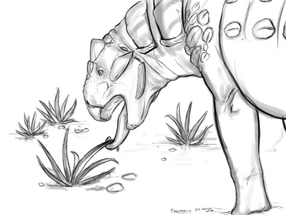
Pinacosaurus uses its tongue to eat vegetation by LeccathuFurvicael.
In 2015, a juvenile specimen was described showing a complex tongue bone apparatus. It included paraglossalia at the sides, paired first and second ceratobranchials and higher epibranchials. Also the bone structure suggested that in the middle a cartilaginous basihyal was present. The strong development of the hyoid would indicate that a powerful tongue compensated for the weakly developed dentition. It was inferred that all dinosaurs had such complex tongue bones but that these were generally lost during fossilisation. This discovery supports the idea, and it is safe to assume most members of Ankylosauridae possessed something similar. The postcranial skeleton of the known fossils is rather lightly built, being mainly from juveniles. However: even the adult specimen IMM 96BM3/1, the P. mephistocephalus holotype, is just about 3 meters. Juveniles had four rear back vertebrae fused into a "sacral rod", three true sacrals, and a tail base of seven vertebrae possessing transverse processes. Behind these about eight "free" vertebrae are present, followed by about twenty vertebrae stiffened by projections and forming the "handle" of the tail club. Like all ankylosaurids, Pinacosaurus had a bony club at the end of its tail which it likely used as a defensive weapon against predators. This club was relatively small, but would prove sufficient against the small theropods that could pose a threat. The torso is incredibly flat compared to most ankylosaurids. The forelimbs are moderately robust; the P. mephistocephalus holotype has a quite robust humerus and ulna, however. The hand is completely known, which is incredibly rare for ankylosaurids. It has five digits, and the phalangeal formula is 2-3-3-3-2, meaning that the innermost finger of the forelimb has two bones, the next has three, etc. The metatarsals are closely appressed and held vertical. The claws are hoof-shaped. In the pelvis, the ilia flare strongly outwards to the front. The ischium is thin and curves forwards. The hindlimbs are moderately robust. The shinbone has a wide underside with well-formed condyles. Currie therefore assumed that the lower leg articulated directly with the metatarsus, the inner part of the astragalus and the entire calcaneum being absent or non-ossified cartilage elements. As in all known ankylosaurids, the foot has three toes, not four as Maryańska assumed in 1977, misled by the damaged specimen ZPAL MgD−II/9. The phalangeal formule of the toes is variable: most individuals have 0−3−3−4−0 but some exemplars possess an extra penultimate phalanx in the third toe, resulting in 0-3-4-4-0, while others lack a phalanx in the fourth toe, which causes a 0-3-3-3-0 configuration.
Osteoderms[]
The configuration of the skin ossifications, or osteoderms, of the body is partly known: no single specimen conserves a complete set. Additional information can be gleaned from the larger specimen MPC 100/1305, a possible Pinacosaurus exemplar. The neck is protected by two cervical halfrings, consisting of keeled rectangular segments fused to an underlying bone band. This band is completely ossified even in juvenile individuals. Godefroit assumed Pinacosaurus differed from other species in having three or four segments instead of the usual six, but Arbour concluded that the normal number was in fact present. The sides of the rump and the tail were occupied by moderately long, flat, recurved, triangular spikes. Parallel rows of smaller oval keeled osteoderms were present on the back. A continuous "sacral shield" on the hip, made of fused plates, is absent.
Phylogeny[]
Originally placed in the Nodosauridae by Gilmore,Pinacosaurus is now considered to be an ankylosaurid and a likely member of the Ankylosaurinae.
The following cladogram is based on a 2015 phylogenetic analysis of the Ankylosaurinae conducted by Arbour and Currie:
| Ankylosaurinae |
| |||||||||||||||||||||||||||||||||||||||||||||||||||||||||||||||||||||||||||
The cladogram below follows the most resolved topology from a 2011 analysis by paleontologists Richard S. Thompson, Jolyon C. Parish, Susannah C. R. Maidment and Paul M. Barrett.
| Ankylosauridae |
| |||||||||||||||||||||||||||||||||||||||||||||||||||||||||||||||||||||||||||||||||||||||||||||||||||||||||||||||
The difference in the relative position of the two Pinacosaurus species between the respective analyses, is influenced by the fact that the best preserved P. grangeri skulls are from juveniles, while the holotype of P. mephistocephalus is an adult with a skull that is longer than it is wide, which might cause a more basal position of the latter.
Paleobiology[]
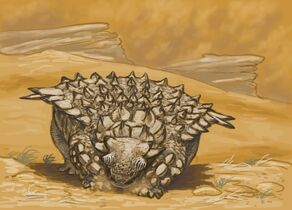
Pinacosaurus roaming the Mongolian deserts by Joschua Knuppe
The habitat of Pinacosaurus consisted of a semi-desert interspersed with oases. No large theropods are known to have inhabited the ecosystem, though smaller ones like Velociraptor were present. While small traces of a large theropod similar to Tarbosaurus has been found, it is likely this was from a later formation which Tarbosaurus is most known for being present in. It has been suggested that the relatively light build of Pinacosaurus was an adaptation to gain agility to better fight small theropods, the moderately large club being fast enough to hit these swift targets. It's relatively flat body and low-slung build would, in addition, may protect it's belly from the small predators.
In a discovery of a group of juvenile Pinacosaurus found together at Bayan Mandahu, the individuals were all oriented into the same direction, possibly suggesting they represent a true herd, likely traveling, and were simultaneously killed and covered by a sandstorm. It is remarkable that the members of such groups are all of about the same age, having an average length of circa 1.5 metres. This could be explained by the larger individuals being able to extract themselves from the sand, leaving the small members of the herd behind but in that case it is strange that no very young animals were found, the smallest being about one metre in length. It is possible that different age groups could have herded together, or there weren't hatchlings from any adult individuals at the time. The concentration of fossils at Alag Teeg has been explained as caused by a drying pool, but later research showed the sediments were deposited during a flood. During their ontogenetic development, in juveniles at first the ribs fused with their vertebrae. The forelimbs strongly increased in robustness, while the hind limbs did not become larger relative to the rest of the skeleton, indicating that the arms bore most of the weight. In the cervical halfrings, the underlying bone band developed outgrowths connecting it with the underlying osteoderms, which simultaneously fused to each other. On the skull, the caputegulae first ossified at the snout and the rear rim; gradually the ossification extended towards the middle regions. On the rest of the body, the ossification process progressed from the neck onwards in the direction of the tail.
A juvenile specimen of Pinacosaurus preserves large paraglossalia, being triangular bones or cartilages located in the tongue, which show possible signs of muscular stress, and it is thought this was a common feature of ankylosaurs for feeding. Pinacosaurus and other ankylosaurs likely relied heavily on muscular tongues and hyobranchia (tongue bones) when feeding, since their teeth were fairly small and were replaced at a relatively slow rate. Some modern salamanders have similar tongue bones, and use prehensile tongues to pick up food. Though Pinacosaurus may not have fed on fibrous and woody plants, they may have had a more varied diet, including tough leaves and pulpy fruits due to their environment. The tongue may have assisted in low-to-the-ground foliage in the Flaming Cliffs.
In 2023, a study was published that showed that Pinacosaurus could "chirp" due to a preserved larynx. Another Asian ankylosaur, Saichania, was also found with a larynx. Though only found in these two closely related genus, it is presumed such a organ would be present on most ankylosaurs. The presence of a larynx means Pinacosaurus could make far more complex, and higher pitched, vocalizations. A common misconception is that Pinacosaurus could sing like a bird due to a similar vocal structure, though many paleontologists are against this, suggesting it likely didn't replicate such sounds directly.
In popular culture[]
- Pinacosaurus appeared in the National Geographic documentary Dinosaur Hunters.
- Pinacosaurus appeared in the video game Dinosaur Adventure 3D.
- Pinacosaurus appeared in Dinosaur King, though the deception is based on older media, looking more like Ankylosaurus or Anodontosaurus than the plank lizard.
- Pinacosaurus appeared in The Truth About Killer Dinosaurs. The ankylosaur in the documentary itself was unidentified. The ankylosaur in question, as implied by the fossil specimen of multiple juveniles, is likely Pinacosaurus. If that is the case, the back is far too hunched and it lacks spikes that would have protruded from the sides of the body.
- Pinacosaurus is featured in the game Dinosaur World Mobile, as a base ankylosaur.
- Pinacosaurus is featured in the manga Dinosaur Sanctuary.
